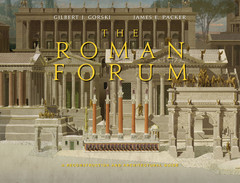The Roman Forum A Reconstruction and Architectural Guide
Langue : Anglais
Auteurs : Gorski Gilbert J., Packer James E.

This richly illustrated volume provides an architectural history of the central section of the Roman Forum during the Empire (31 BCE–476 CE).
The Roman Forum was in many ways the heart of the Roman Empire. Today, the Forum exists in a fragmentary state, having been destroyed and plundered by barbarians, aristocrats, citizens and priests over the past two millennia. Enough remains, however, for archaeologists to reconstruct its spectacular buildings and monuments. This richly illustrated volume provides an architectural history of the central section of the Roman Forum during the Empire (31 BCE?476 CE), from the Temple of Julius Caesar to the monuments on the slope of the Capitoline hill. Bringing together state-of-the-art technology in architectural illustration and the expertise of a prominent Roman archaeologist, this book offers a unique reconstruction of the Forum, providing architectural history, a summary of each building's excavation and research, scaled digital plans, elevations, and reconstructed aerial images that not only shed light on the Forum's history but vividly bring it to life. With this book, scholars, students, architects and artists will be able to visualize for the first time since antiquity the character, design and appearance of the famous heart of ancient Rome.
Part I. Architecture in the Roman Forum during the Empire: A Brief History: 1. The Augustan Reconstruction; 2. From the Tiberius to Phocas (14–608 CE); Part II. The Monuments: 3. The Temple of Antoninus and Faustina; 4. The Temple of Caesar (Aedes divi Iuli); 5. The Basilica Aemilia; 6. The Curia; 7. The Arch of Septimius Severus; 8. The West Rostra; 9. The Temple of Concord; 10. The Temple of Vespasian; 11. The Tabularium; 12. Portico of the Dei Consentes; 13. The Temple of Saturn; 14. The Basilica Julia; 15. The Arch of Tiberius; 16. The Schola Xanthi; 17. The Diocletianic Honorary Columns; 18. The Temple of Castor and Pollux; 19. The Parthian Arch of Augustus; 20. The Temple of Vesta; Part III. Conclusions.
Gilbert J. Gorski is a licensed architect and the project designer for numerous buildings including the World Headquarters for the McDonald's Corporation in Oak Brook, IL, and the Oceanarium, a major addition to the John G. Shedd Aquarium in Chicago. In 1987 he was designated the Burnham Fellow by the Chicago Architectural Club and was awarded an associate fellowship to the American Academy in Rome. Since 1989 Gorski has headed his own firm specializing in design and illustration. His drawings and paintings have been included in numerous publications and exhibits on architecture and illustration. He was twice awarded the Hugh Ferriss Memorial Prize, the nation's highest singular honor in architectural illustration, by the American Society of Architectural Illustrators. He is also the recipient of an Institute Honor for Collaborative Achievement, awarded by the American Institute of Architects. He presently is an associate professor at the University of Notre Dame and holds the James A. and Louise F. Nolen Chair in Architecture.
James E. Packer is Emeritus Professor of Classics at Northwestern University. He is the author of the three-volume The Forum of Trajan in Rome (1997); of numerous articles in journals, including the American Journal of Archaeology, the Journal of Roman Archaeology, the Bullettino della Commissione Archeologica Comunale di Roma, the Maryland Historian, Natural History, Croniche Pompeiane, Technology and Culture, Curator, Inland Architect, Archeo, and Archaeology; and of articles in collections, including the Lexicon Topographicum Urbis Romae (1993–2000). He is the recipient of many grants, including those from the Samuel H. Kress Foundation, the Getty Grant Program, the National Endowment for the Humanities, and the Andrew W. Mellon Foundation. He has excavated at Pompeii, in the Forum of Trajan (Rome), and in the Theater of Pompey (Rome). 'The Forum of Trajan' exhibition at the opening of the new Getty Museum in Los Angeles (1997) was bas
James E. Packer is Emeritus Professor of Classics at Northwestern University. He is the author of the three-volume The Forum of Trajan in Rome (1997); of numerous articles in journals, including the American Journal of Archaeology, the Journal of Roman Archaeology, the Bullettino della Commissione Archeologica Comunale di Roma, the Maryland Historian, Natural History, Croniche Pompeiane, Technology and Culture, Curator, Inland Architect, Archeo, and Archaeology; and of articles in collections, including the Lexicon Topographicum Urbis Romae (1993–2000). He is the recipient of many grants, including those from the Samuel H. Kress Foundation, the Getty Grant Program, the National Endowment for the Humanities, and the Andrew W. Mellon Foundation. He has excavated at Pompeii, in the Forum of Trajan (Rome), and in the Theater of Pompey (Rome). 'The Forum of Trajan' exhibition at the opening of the new Getty Museum in Los Angeles (1997) was bas
Date de parution : 06-2015
Ouvrage de 457 p.
23.5x31.2 cm
© 2024 LAVOISIER S.A.S.



